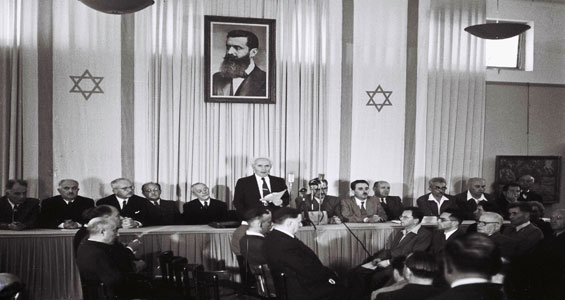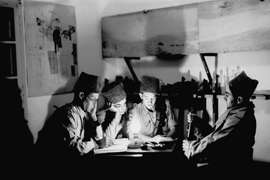The fall of an Arab town in 1948
Author Sandy Tolan recounts the events leading to the surrender of Al-Ramla in 1948.

 |
| David Ben-Gurion declares the state of Israel on May 14, 1948 in this file photo [GALLO/GETTY] |
On the evening of July 11, 1948, in the town of al-Ramla on the coastal plain of Palestine, the sons and daughters of the town patriarch huddled together in the family compound.
There was flour in the storehouse, enough for a few days’ supply of bread, if the family chose to hold out a little longer.
But enemy forces were drawing closer. Even for Sheikh Mustafa al-Khairi, head of one of the “notable” families of al-Ramla, the inevitable could not be delayed much longer.
The shutters were drawn tight against the sound of nearby explosions.
And now there was news of an Israeli infantry assault on the nearby town of Lydda, a few miles to the southeast, where scores of Palestinians were reported killed.
One American correspondent would write, “the corpses of Arab men, women and even children [were] strewn about in the wake of the ruthlessly brilliant charge.”
Surrender
Sheikh Mustafa, until recently the mayor of al-Ramla, had to make a decision from the family’s shuttered room. Word of the carnage had reached the shelters of al-Ramla, where Dr Rasem Khairi, Sheikh Mustafa’s nephew, was tending to the wounded in his makeshift shelter.
That evening, shortly after Arab-run Radio Jerusalem broadcast a recording of Beethoven’s First Symphony, the few Arab forces pledged to defend the town abandoned their posts in al-Ramla, melting into the plains to fight another day in another place.
Al-Ramla was left in the hands of its young Arab defenders who were armed with some old rifles and crude rockets they launched from the branches of trees.
Sheikh Mustafa knew enemy forces would soon arrive to repeat the assault on Lydda. He realised that the unthinkable had become the only choice. He ordered his son, Husam, with other prominent families, to ride to the nearby Jewish kibbutz of Na’an, to sign a document whose name the family dared not speak: surrender.
The surrender, occupation and ultimate expulsion of the Arab residents of al-Ramla, along with the more brutal assault and expulsion of Lydda, were part of the Israeli military’s Operation Dani of July 1948.
For Palestinians, those days lie at the heart of the collective memory of the Nakba, or Catastrophe, 60 years later.
The events of mid-July 1948 show that, unlike traditional accounts by Israel and those conveyed to many Americans, Arabs did not leave their homes willingly or in order to make way for avenging Arab armies, but were, in many cases, driven from their homes as part of a co-ordinated plan by leaders of the Jewish state.
Remove the ‘obstacle’
 |
| Israeli militias attacked Arab towns before Operation Dani’s launch in 1948 [GETTY] |
Documents of Operation Dani unearthed from Israeli state and local kibbutz archives, and the writings of Israeli military commanders in al-Ramla and Lydda in July 1948, demonstrate beyond doubt that the expulsions from the two towns were part of a military plan, in part to remove the “obstacle” of an Arab population on the main route between Tel Aviv and Jerusalem.
(Zionist leaders had long spoken of securing the road from attacks from on Jewish convoys.)
Yitzhak Rabin, the late Israeli prime minister who was an army major during Operation Dani, wrote that David Ben-Gurion, the Zionist leader and first Israeli prime minister, ordered the expulsions.
Rabin’s commander, Yigal Allon, described the military advantages of those expulsions in a 1948 Israeli military journal. And a Na’an kibbutz leader, Israel Galili B, who, like some other early Israelis had opposed the expulsions, wrote that Ben-Gurion had ordered the Israeli soldiers to “evacuate al-Ramla”.
For the Khairis – and for tens of thousands of Palestinians in the towns of al-Ramla and Lydda – the brutal shock of mid-July 1948 was in stark contrast to the hope and defiance that marked the Arab rejection of the UN partition plan scarcely seven months earlier.
Though al-Ramla and Lydda would have stayed on the “Arab side” in a two-state partition, just a few kilometres from the Jewish state, Palestinian Arabs did not want separate Arab and Jewish states: They wanted one state for all, and declared their willingness to fight for it.
Zionist leaders, including Ben-Gurion, had embraced the plan publicly, though he would worry in private about the Arab minority, which made up at least 45 per cent of the outlined Jewish state.
“With such a composition,” he told a group of Jewish labour leaders a month after the UN vote, “there can be no absolute certainty that control will remain in the hands of the Jewish majority.”
Needed, Ben-Gurion declared, was “a new approach … new habits of mind to suit our new future. We must think like a state.”
Plan: Eretz-Yisrael
 |
| Members of the Israeli Haganah forces plan a raid [GALLO/GETTY] |
Less than three months later, Zionist strategists meeting in Tel Aviv designed Plan D – “a secret plan”, according to a prominent Israeli historian.
It was “the final phase of which would be all of Eretz-Yisrael” – meaning, the conquest of both the Arab and Jewish sides of the partition.
The Plan D blueprint, drawn up on March 10, 1948, declared itself defensive in nature: it was “not an operation of occupation outside the borders of the Hebrew state.”
But it called for “aiming control of the areas of Jewish settlement and concentration which are located outside the borders”, and for occupation of “enemy bases lying directly close to the borders which may be used as springboards for infiltration into the territory of the state.”
Among the tactics Plan D outlined: “Destruction of villages (setting fire to, blowing up, and planting mines in the debris), especially those population centres which are difficult to control continuously.”
In April 1948, the Khairi home in al-Ramla was jolted by a series of blasts coming from the edge of town. The headquarters of Hassan Salameh, one of the key commanders charged with defending the town, had been blown up. The commander survived, but 17 of his men did not.
Just as the Khairis and their neighbours began wondering if their town could withstand more attacks, now came two more devastating pieces of news: Adb al-Qader al-Husseini, the Palestinians’ most revered commander, had been killed in the battle for Qastal, near Jerusalem.
And on the same day, the Jewish militia known as the Stern Gang, aided by Irgun, massacred more than 125 unarmed men, women and children in the village of Deir Yassin.
Three days later, Arabs attacked a Jewish convoy on the road to the Hadassah Hospital in a retaliation massacre, killing at least 78, mostly doctors and nurses.
Deir Yassin’s terror
| Related Articles |
|
Tracing Gaza’s Chaos to 1948 The Nakba: Catalyst for pan-Arabism Opinion: Arabism’s greatest loss Realising the Zionist dream Why the Arabs were defeated |
The Deir Yassin massacre, more than any other single event, sent waves of fear across Arab Palestine; many families began to flee their villages, especially in the wake of “whispering campaigns”, some organised by Yigal Allon, of impending attacks by Jewish forces.
As the result of one such campaign, the Arab village of Na’ani was abandoned, and many of the villagers took refuge on the streets of al-Ramla.
On May 15, the day after David Ben-Gurion declared Israel’s statehood, the war officially began, as neighbouring Arab states joined the battle.
What Israel considered attempts by the Arabs to wipe it off the map, Palestinian villagers saw as an attempt to save them from living as a minority in an alien state. That same day, the Irgun began a series of attacks on al-Ramla.
The town’s local defenders lay behind sandbags in shallow drenches they had dug with oxen and hand tools. “The whole city,” an Israeli newspaper would recount, “became one big battlefield.”
On May 19, the attacks were finally repulsed. But the spectre of the Irgun penetrating the town’s defences had evoked fears of another Deir Yassin-like massacre.
As Dr Rasem Khairi bandaged wounded fighters in his makeshift clinic, Khairi elders made plans to send their children to safety in the nearby Christian hill town of Ramallah. They assumed it would be for just a short time.
Ill-equipped, barefoot
| Fact file: Sir John Glubb |
|
Sir John Glubb Pasha (1897-1986), also known as Glubb Pasha, was a British general best known for commanding the Transjordan Arab Legion between 1939 and 1956. He is credited with transforming the Arab Legion into one of the strongest armies in the Arab world. In 1956, King Hussein of Jordan sacked Glubb Pasha as part of his efforts to solidify his status in the Arab world. |
In al-Ramla, the Khairis watched as the situation went from bad to worse.
In late May, commander Hassan Salameh himself was killed, and his fighters, leaderless, drifted away.
Now the defence of the town was left largely to barefoot Bedouins sent by King Abdullah of Transjordan, whose main objective was not to confront Israel, but to capture the West Bank for his Hashemite kingdom.
The members of the ill-equipped, ill-humoured “barefoot brigade” would be remembered for their bravery and for their hunger: they often used their rifles to shoot pigeons for food.
But they would be no match for the Israeli forces, which, during a June ceasefire, had managed to break a UN arms embargo and smuggle in fighter planes, tanks, rifles, and millions of rounds of ammunition.
The Arab side, under the influence of the British, had adhered to the embargo, and thus King Abdullah’s fighters, at the end of the ceasefire, found themselves almost out of bullets.
“How are we to fight without ammunition?” the commander of King Abdullah’s Arab Legion, Glubb Pasha, asked Transjordan’s prime minister.
“Don’t shoot,” came the reply, “unless the Jews shoot first.”
And so it was that two days after the end of the ceasefire, on July 11, 1948, the battle-hardened Jewish army stormed the town of Lydda, easily overwhelming their ragtag forces, and marching inexorably toward al-Ramla.
For Sheikh Mustafa, there was no choice but to send his son to the nearby kibbutz to surrender.
He did so on the evening on July 11. The surrender document declares that the Arab residents of the town could choose to leave, “if they want to”; implicit, and understood by parties from both sides who signed the agreement, was that the Arabs could also choose to stay.
Quickly, the people of al-Ramla learned of a new reality. On July 12, Israeli soldiers began pounding on doors with the butts of their guns, shouting through bullhorns, “Yallah Abdullah! Go to Abdullah, go to Ramallah!”
The residents of al-Ramla and Lydda were being expelled by force of arms.
Sandy Tolan is the author of The Lemon Tree: An Arab, A Jew, and the Heart of the Middle East, from which this account is drawn. He is associate professor of journalism at the Annenberg School for Communication, University of Southern California.